Google Current Mission
Google is a leading world technology firm that aims at improving people’s information and attachment.
The firm’s aspiration is to improve the lives of a multitude number of world inhabitants.
The firm’s mission is to categorize information and make it helpful and easily reached by people around the globe.
Essentially, the firm’s mission is to organize the global information and make it accessible to all people around the world (Google, 2013).
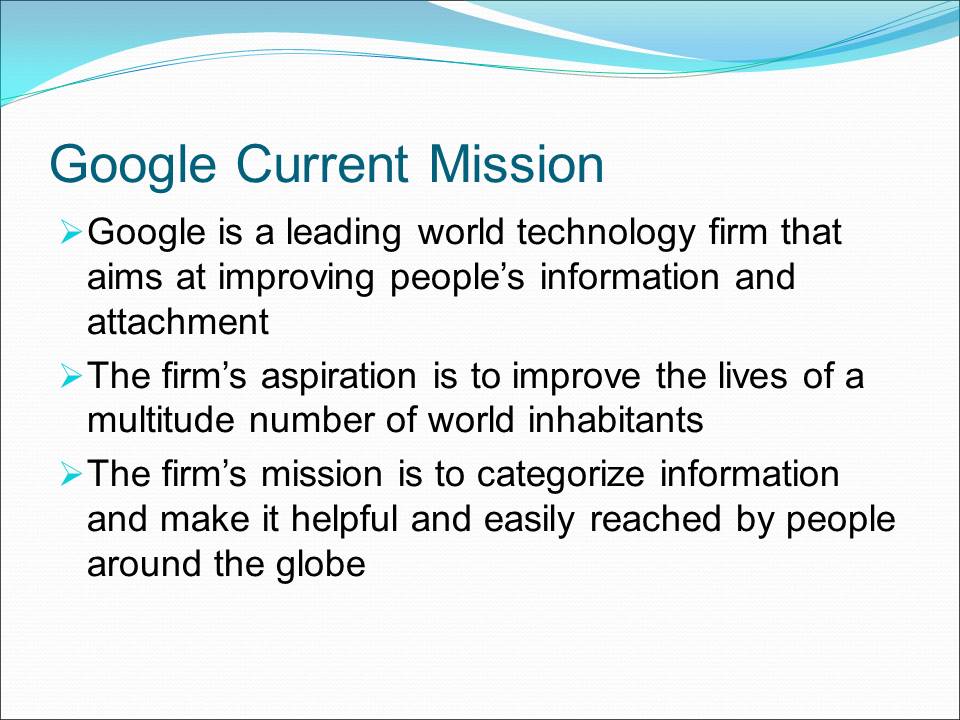
Google’s Objectives and Strategies
Google ‘s main objective is to provide a website, which is most acknowledged in the whole world due to:
- Innovativeness in advertisement.
- Web search.
Besides, the firm aims to convey relevant cost-effective online advertisement critical in generating income for the business sustainability.
Google aims to provide other businesses with Ad Word programme innovative software used in promoting products and services.
The firm aims to apply the network Ad Sense programme to provide relevant ads that would improve user experience and breed profits.
Google’s main strategies include:
- Innovation.
- Concentric diversification.
The search engine is the main business of the firm. Google has built its business through the differentiation strategy of its core business, which is the search engine (Google, 2013). However, currently, the firm’s strategies concentrates around innovation and concentric diversification (Google, 2013).
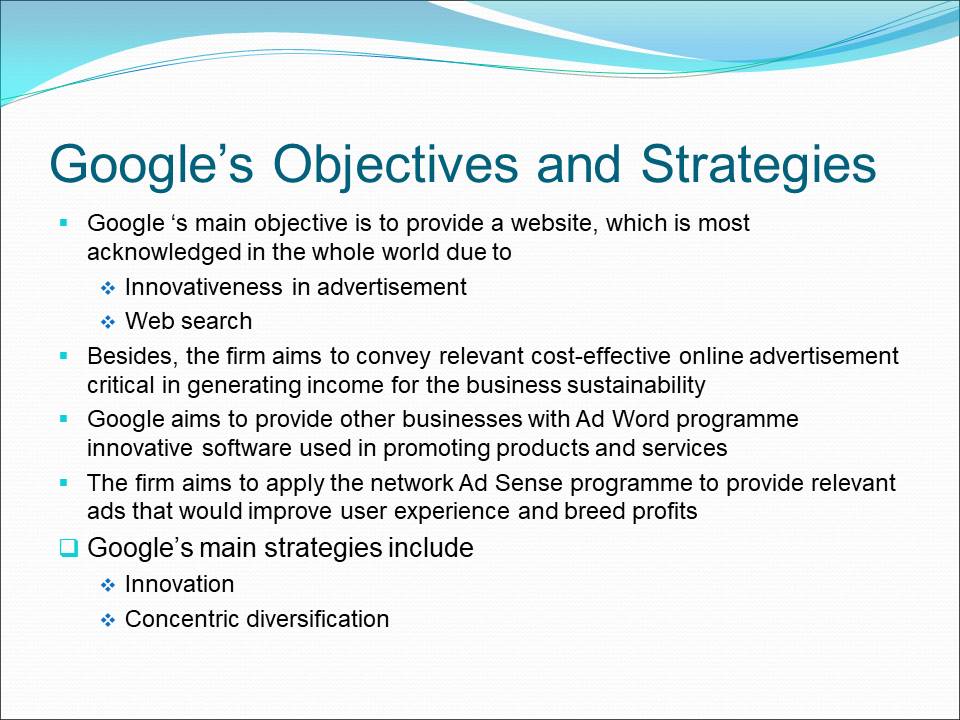
Google’s Current Financial Position
- The firm’s market capitalization is valued at $395.34 billion.
- The price earnings ratio of the firm is about 30.63.
- The price to book ratio is around 4.14.
- The firm’s enterprise value is around $346.96 billion.
- Net profit margin is about 20.29%.
- The operating profit margin is about 23.41%.
- The revenue growth is estimated to be about $64.14 billion annually.
- The revenue growth translates into 97.06 per share.
- EBITDA is around $19.42 billion.
- Return on assets is estimated to be about 8.56%.
- Return on equity is about 14.95%.
- Current ratio is about 4.56.
- The book value per share is estimated to be around 141.66.
Given the financial ratios, the indication is that the firm is financially sound. Besides, given the revenue growth indicators, the firm has a potential for future growth (Yahoo Finance, 2014). In fact, it is estimated that the firm revenues will grow by over 6% in the coming financial year, which is the highest in the industry. Similarly, returns of equity and assets are also expected to grow by over 3%. The financial stability is indicated in the current ratio. In fact, the 4.56 indicates that the firm can easily offset its short-term financial requirements.
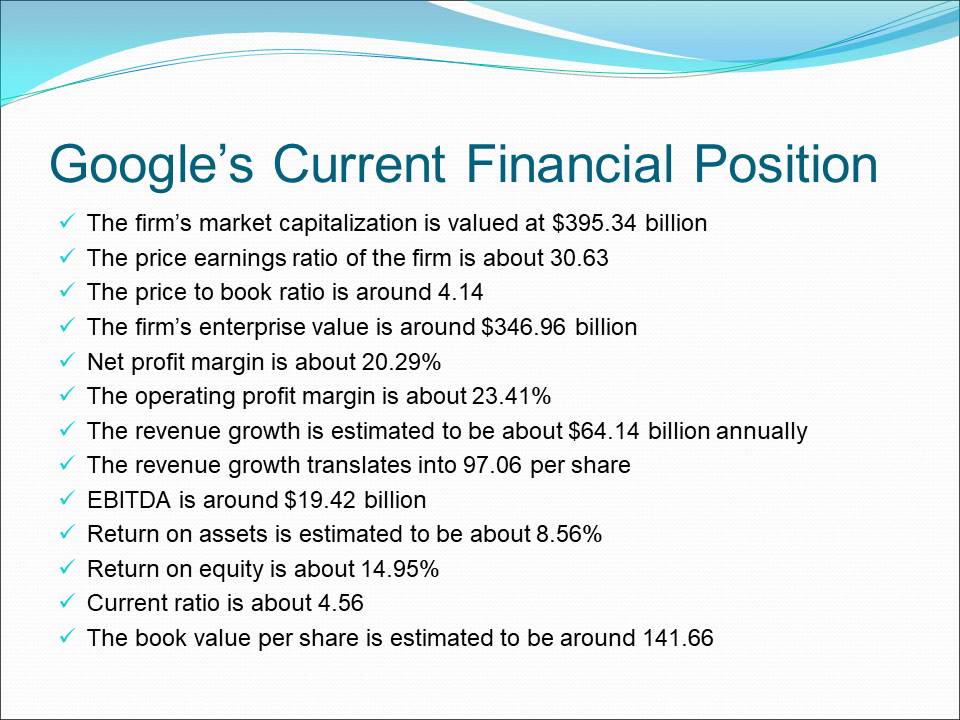
Google’s External Opportunities and Threats
The opportunities include:
- Expand in new business areas.
- Expansion of services particularly in unmapped countries.
- Novel advertisement formats and tracking mechanisms.
- Increased size of customer base.
- Leveraged advertising agreements.
The threats include:
- Increased competition from newly formed and major technology firms.
- Increased claims of intellectual property.
- Reducing operating margins resulting from intellectual claims and competition.
- Shrinking advertising budgets.
Other factors such as increased international competition are also considered threat facing the firm. In addition, new regulations both within the domestic and international fronts also threaten the firms operations.
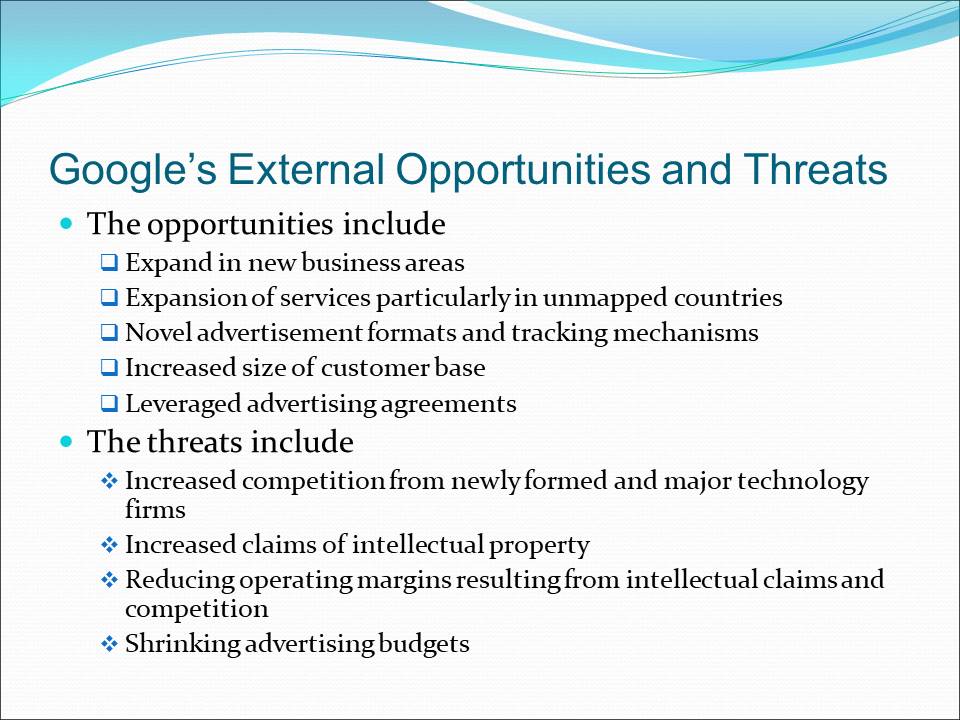
Google’s Internal Strengths and Weaknesses
The internal strengths of the firm include:
- Strong brand name.
- Wide appeal web browsing services.
- Innovative search technology.
- Large return on investments from web advertisers.
Google weaknesses include:
- Dependence on advertising as the major source of revenue.
- Lack of popularity of the member networks.
- Weak positions in developing economies such as China.
- Dependence on search engine as the main product line.
- Lack of experienced and skilled employees.
The tool used in the analysis of the strategic internal environment represents the realistic internal resources of the firm. In other words, the internal attributes portray a resource-based view of the firm (Weiner, 2004).
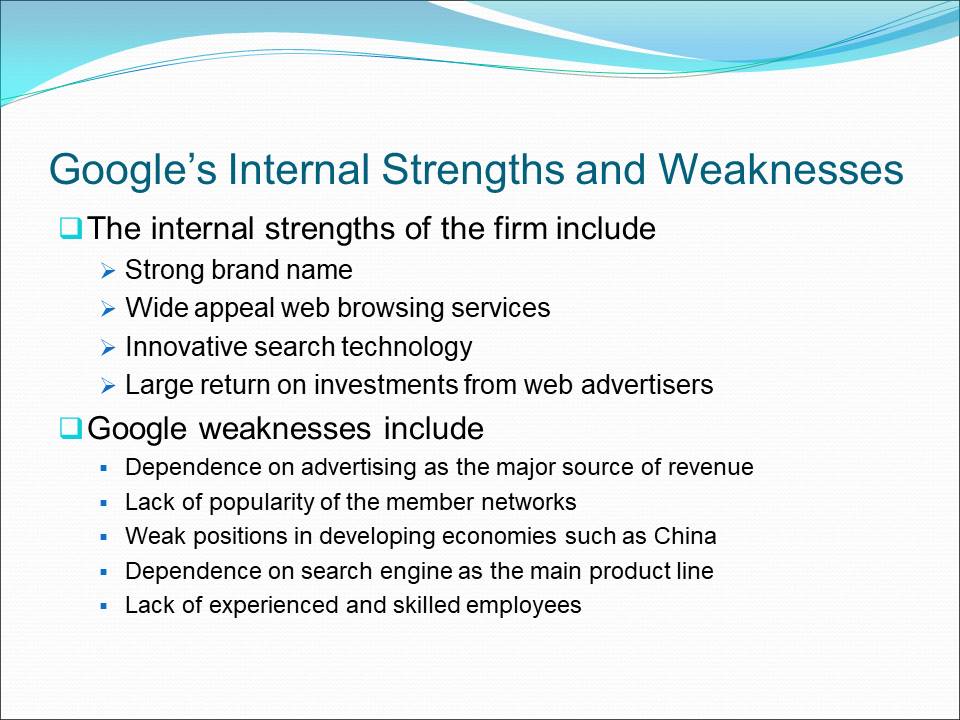
The Firm’s Mission and Long-Term Objectives
vWith the mission of categorizing information and making it helpful and easily reached by many people around the globe, the firm’s long-term objectives include:
- To deliver new technologies in advertising.
- Developing new tracking mechanisms.
- Developing a new search engine capable of holding large base of information.
The highly transformation nature of technology characterizes the environment in which the firm operates. To keep up with the changes and remain in the competitive environment, the firm intends to deliver the three mentioned objectives. In fact, holding on to the patents and intellectual property rights as well as retention and recruitment of the highly skilled human resources hold the key to gaining and maintaining the competitive advantage in the market (Mahaney, 2005).
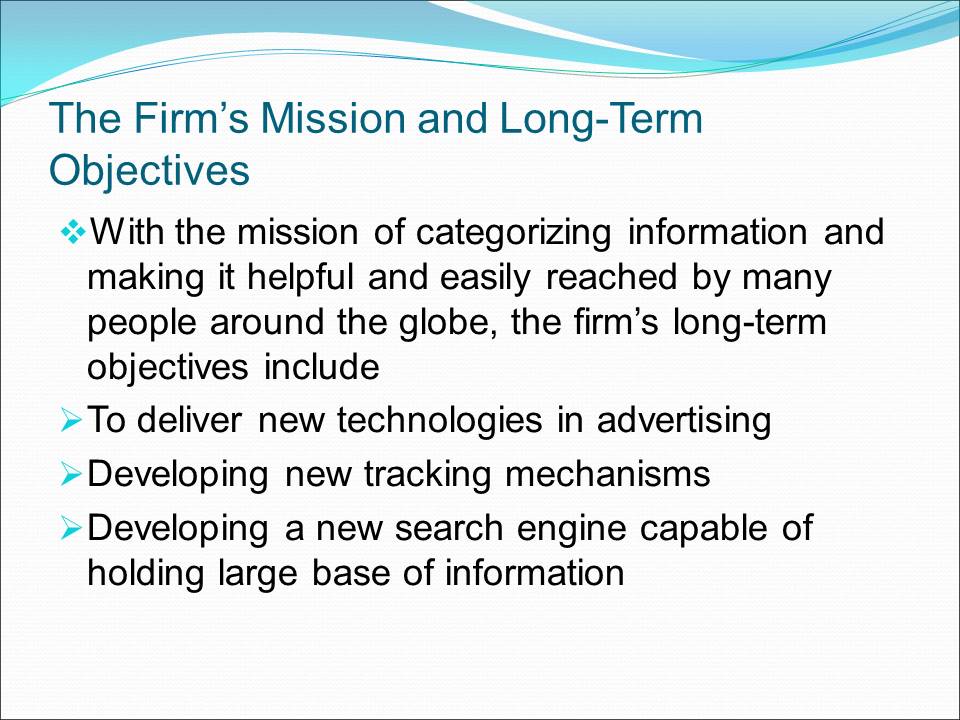
Business and Corporate Strategies to Achieve the Mission and Objectives
Given that the firm’s business is based on a single product line, Google has adopted the following corporate and business strategies to remain competitive in the market:
- The differentiation strategy.
- Concentric diversification.
- Low-cost and quality services strategy.
- Delivery of speedy search engine.
Google has been employing diverse strategies in order to attain its mission and major objectives. While differentiation strategy has enabled the firm to achieve its leadership status in the industry, the firm has been keen in offering faster and speedy search engine at the lowest cost possible (Chaffey, 2007). In other words, the low-cost and speed has provided the firm with an additional competitive advantage (Hardy, 2005).
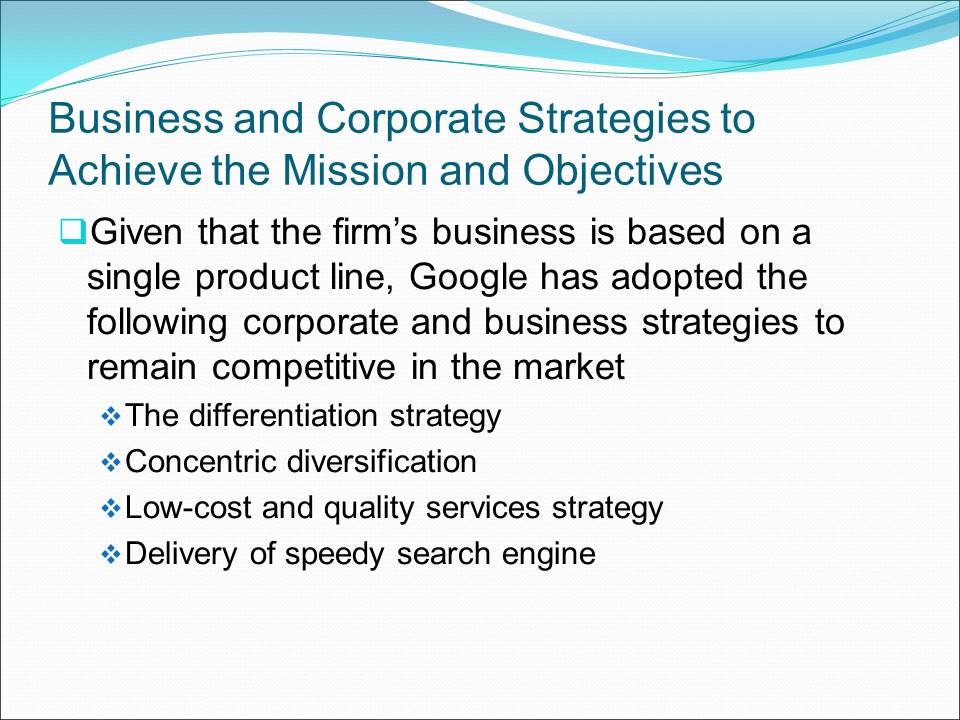
Implementation Plan of Long-Term Objectives and Strategies
The firm’s long-term objectives include:
- Expanding the skilled human resources for the anticipated growth.
- Expanding further into international market including developing economies such as China.
- Continuous development of new products in order to remain competitive.
- Continuous development and delivery of new advertising technology.
In order to attain the objectives, the firm intends to:
- Expand its workforce.
- Restructure and adopt horizontal corporate design.
- Encourage innovation and idea generation among the employees.
The long-term objectives are in line with specific short term goals. In fact, the continuous expansion of the skilled human resources remains critical in attaining the long-term objectives of the firm (Google, 2013). The firm’s human resources is committed to employ a highly skilled workforce and encourage innovation among the employees. Besides, the firm’s structure and the corporate management style are geared towards developing and encouraging innovation among the workforce (Dwivedi, 2008).
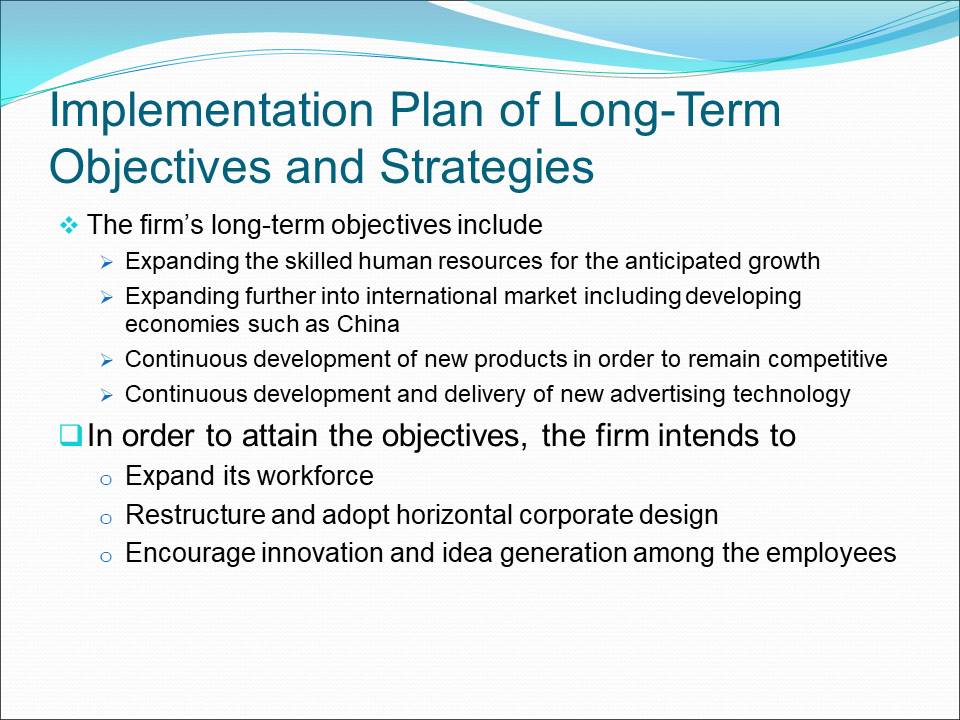
Specific Annual Objectives and Policies in Attaining the Strategic Goals
The annual objectives include:
- Employees recruitment, retention and development.
- Agreements and investments in key business areas.
- Diversification of product delivery.
Google business strategies are aligned with new investment areas as well as agreements with related firms to deliver the competitive advantage and gain larger market share (Starkey, 2009). Besides, significant success factors that led to the success of the firm in this fiscal year are also aligned with employees’ retention and development (Google, 2013).
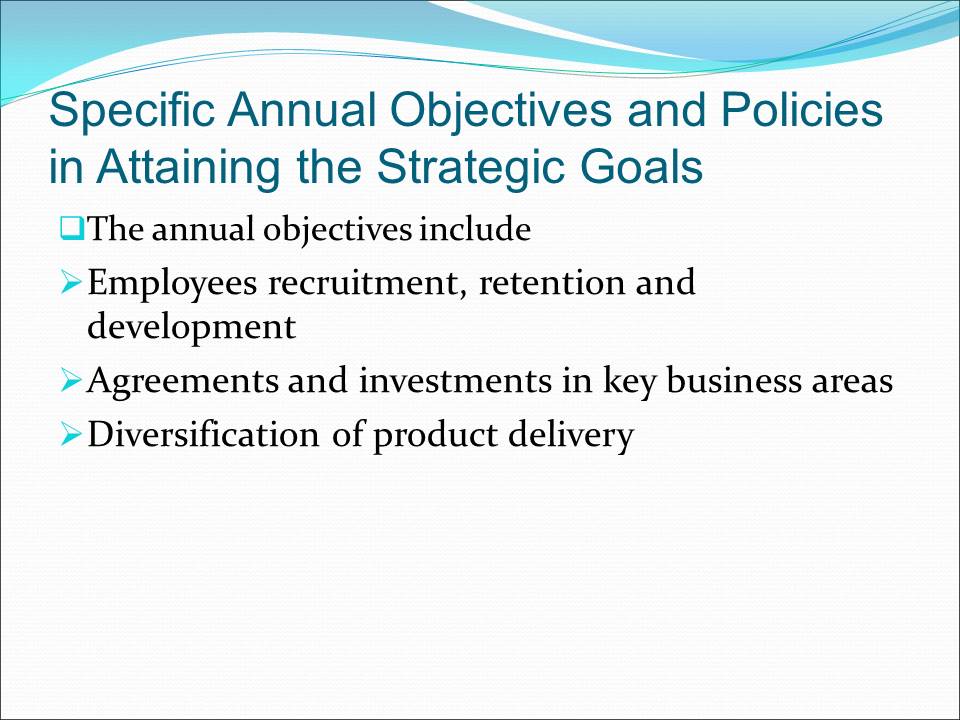
Expected Results
The attainment of the strategic goals will result in:
- New products that differentiate the firm from major competitors.
- Increased market share.
- Increased competitive advantage.
- Increased financial performance including.
- Augmented market capitalization.
- Higher profit margins.
- Higher share prices.
- Increased returns on investments.
The attainment of the firm’s objectives results in increased performance in all business processes. In particular, the firm is expected to realize huge returns on investments in form of profits and dividends to the shareholders. The improvements in the firm’s income statements and balance sheet are a clear indication of increased opportunities for future growth (Google, 2013).

Strategy Review and Evaluation
The strategies will be assessed in terms of:
- The success of the target objective.
- Time taken to implement the strategic objective.
- The effect the strategy has in the general operations of the firm.
- Internal and external environmental factors.
- New technological developments.
The strategies that have been put in place are majorly affected by both internal and external environmental factors. The firm’s systems and operations are vulnerable to environmental conditions such as the power outages and highly changing technological environment (Google, 2013). Besides, new technological developments such as mobile phones that are not compatible with the Google operating systems may also affect the strategic implementations in order to attain the intended objectives.
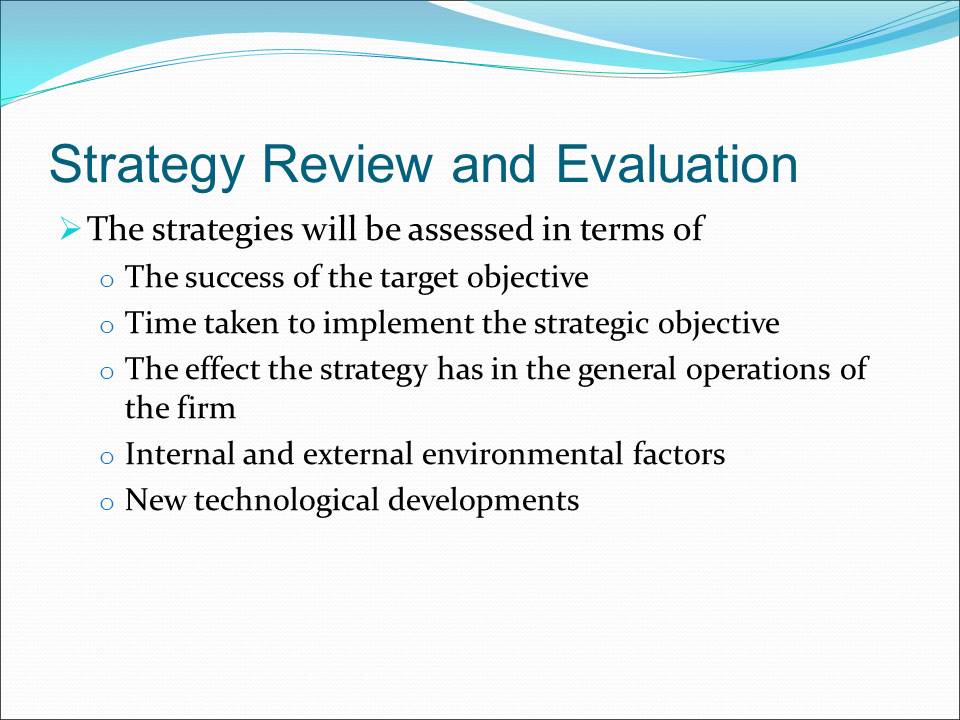
Strategic Control Measures
Monitoring the strategies involves certain measures including:
- Developing the contingency plans.
- Continuous monitoring of competition.
- Expanding current product offering.
- Continuous gathering of consumer information.
- Establishing realistic time frames and specific goals.
- Identifying the correct monitoring system.
The continuous evaluation of the strategies involves various activities such as the development of the contingency plans that can mitigate against the environmental threats such as new inventions(Google, 2013). In order to develop appropriate contingency plan, continuous monitoring of the competitive environment is required. Besides, continuous expansion of product offering and collection of the market information remains critical in developing appropriate contingency plans, which enables the firm to remain competitive in the market. Coming up with realistic time frames as well as strategic goals for milestone assessments is also critical particularly in an industry which is highly tranforming.
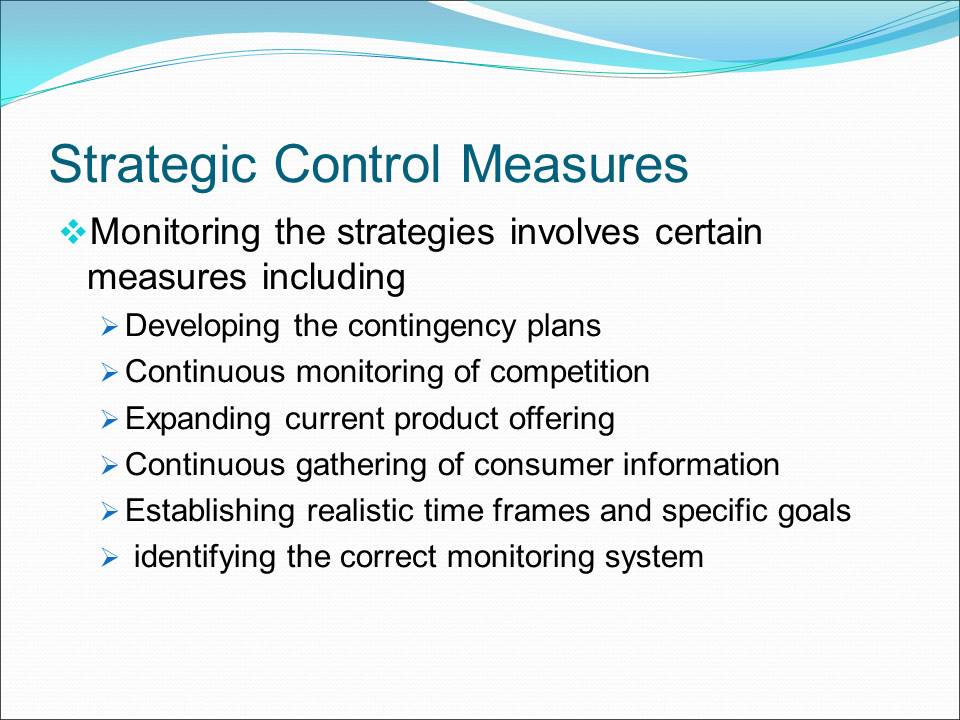
References
Chaffey, D. (2007). Google case study-covering Google business strategy and technology case. Web.
Dwivedi, J. (2008), Google’s robust strategy and business model. Web.
Google (2013). Form 10-K.
Hardy, Q. (2005). Google thinks small. Forbes, 176(10), 198-202.
Mahaney, M. (2005). GOOG: Increased conviction in Google. San Francisco: Citigroup Global Markets, Inc.
Starkey, K. (2009). Strategic management: issues and cases. Hoboken, NJ: John Wiley & Sons.
Weiner, A. (2004). Google files for IPO: The opportunities and challenges.
Yahoo Finance (2014), Google financials: Key statistics.